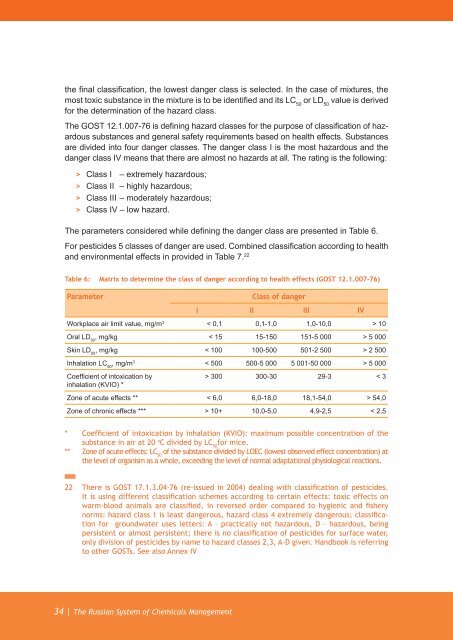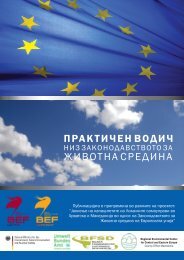The Russian system of chemicals management - Bef-de.org
The Russian system of chemicals management - Bef-de.org
The Russian system of chemicals management - Bef-de.org
Create successful ePaper yourself
Turn your PDF publications into a flip-book with our unique Google optimized e-Paper software.
the final classification, the lowest danger class is selected. In the case <strong>of</strong> mixtures, the<br />
most toxic substance in the mixture is to be i<strong>de</strong>ntified and its LC 50<br />
or LD 50<br />
value is <strong>de</strong>rived<br />
for the <strong>de</strong>termination <strong>of</strong> the hazard class.<br />
<strong>The</strong> GOST 12.1.007-76 is <strong>de</strong>fining hazard classes for the purpose <strong>of</strong> classification <strong>of</strong> hazardous<br />
substances and general safety requirements based on health effects. Substances<br />
are divi<strong>de</strong>d into four danger classes. <strong>The</strong> danger class I is the most hazardous and the<br />
danger class IV means that there are almost no hazards at all. <strong>The</strong> rating is the following:<br />
>><br />
>><br />
>><br />
>><br />
Class I – extremely hazardous;<br />
Class II – highly hazardous;<br />
Class III – mo<strong>de</strong>rately hazardous;<br />
Class IV – low hazard.<br />
<strong>The</strong> parameters consi<strong>de</strong>red while <strong>de</strong>fining the danger class are presented in Table 6.<br />
For pestici<strong>de</strong>s 5 classes <strong>of</strong> danger are used. Combined classification according to health<br />
and environmental effects in provi<strong>de</strong>d in Table 7. 22<br />
Table 6: Matrix to <strong>de</strong>termine the class <strong>of</strong> danger according to health effects (GOST 12.1.007-76)<br />
Parameter<br />
Class <strong>of</strong> danger<br />
I II III IV<br />
Workplace air limit value, mg/m 3 < 0,1 0,1-1,0 1,0-10,0 > 10<br />
Oral LD 50<br />
, mg/kg < 15 15-150 151-5 000 > 5 000<br />
Skin LD 50<br />
, mg/kg < 100 100-500 501-2 500 > 2 500<br />
Inhalation LC 50<br />
, mg/m 3 < 500 500-5 000 5 001-50 000 > 5 000<br />
Coefficient <strong>of</strong> intoxication by<br />
inhalation (KVIO) *<br />
> 300 300-30 29-3 < 3<br />
Zone <strong>of</strong> acute effects ** < 6,0 6,0-18,0 18,1-54,0 > 54,0<br />
Zone <strong>of</strong> chronic effects *** > 10+ 10,0-5,0 4,9-2,5 < 2,5<br />
* Coefficient <strong>of</strong> intoxication by inhalation (KVIO): maximum possible concentration <strong>of</strong> the<br />
substance in air at 20 o C divi<strong>de</strong>d by LC 50<br />
for mice.<br />
** Zone <strong>of</strong> acute effects: LC 50<br />
<strong>of</strong> the substance divi<strong>de</strong>d by LOEC (lowest observed effect concentration) at<br />
the level <strong>of</strong> <strong>org</strong>anism as a whole, exceeding the level <strong>of</strong> normal adaptational physiological reactions.<br />
22 <strong>The</strong>re is GOST 17.1.3.04-76 (re-issued in 2004) <strong>de</strong>aling with classification <strong>of</strong> pestici<strong>de</strong>s.<br />
It is using different classification schemes according to certain effects: toxic effects on<br />
warm-blood animals are classified, in reversed or<strong>de</strong>r compared to hygienic and fishery<br />
norms: hazard class 1 is least dangerous, hazard class 4 extremely dangerous; classification<br />
for groundwater uses letters: A – practically not hazardous, D – hazardous, being<br />
persistent or almost persistent; there is no classification <strong>of</strong> pestici<strong>de</strong>s for surface water,<br />
only division <strong>of</strong> pestici<strong>de</strong>s by name to hazard classes 2,3, A-D given. Handbook is referring<br />
to other GOSTs. See also Annex IV<br />
34 | <strong>The</strong> <strong>Russian</strong> System <strong>of</strong> Chemicals Management



